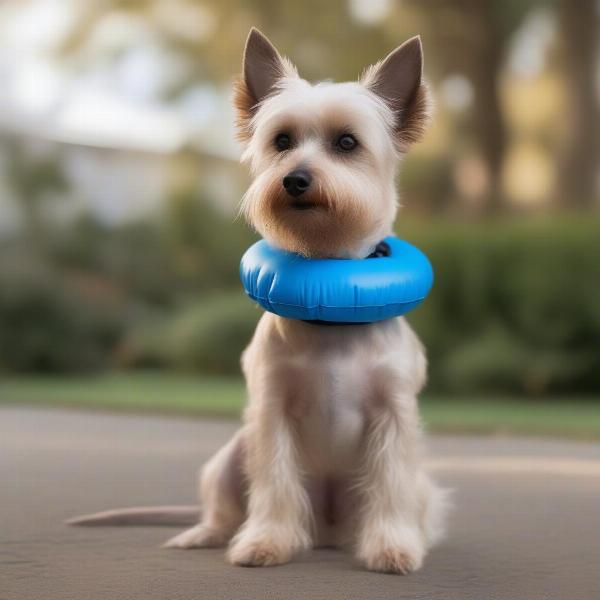After your furry friend undergoes surgery, a dog collar plays a crucial role in their recovery. It prevents them from licking or biting their incision site, which can lead to infections, delayed healing, and even the need for further surgery. Choosing the right collar and ensuring its proper use is vital for a smooth and comfortable recuperation. This guide covers everything you need to know about using a dog collar after surgery.
Choosing the Right Collar
Several types of collars are suitable for post-operative use. The best choice depends on your dog’s size, breed, temperament, and the type of surgery they had.
E-Collars (Elizabethan Collars)
The traditional “cone of shame” is readily available and affordable. While effective, some dogs find them cumbersome and may struggle to eat, drink, or navigate their surroundings. Consider inflatable or soft E-collars for a more comfortable option.
Soft Collars
These collars are made of padded fabric and resemble a neck brace. They restrict head movement, making it difficult for dogs to reach their incisions. Soft collars are generally more comfortable than E-collars but may not be suitable for all dogs, especially those determined to lick or chew.
Inflatable Collars
 Inflatable collar for a dog after surgery
Inflatable collar for a dog after surgery
These donut-shaped collars offer more comfort and freedom of movement than traditional E-collars. However, they might not be suitable for dogs who can still reach their incisions with their mouths due to the collar’s shape.
Surgical Recovery Suits
These suits cover the incision site and provide a barrier against licking and biting. They can be a good alternative for dogs who find collars stressful.
Ensuring Proper Fit and Use
A properly fitted collar is crucial for effectiveness and comfort. It should be snug enough to prevent the dog from reaching the wound but not so tight that it restricts breathing or causes discomfort. Always follow your veterinarian’s instructions on how to fit and use the collar.
Monitoring Your Dog
Regularly check the collar for any signs of damage or wear and tear. Monitor your dog’s behavior and ensure they are adapting to the collar. If your dog seems overly stressed or the collar is causing irritation, consult your veterinarian.
Dealing with Common Challenges
Some dogs may initially resist wearing a collar. Patience and positive reinforcement are key. Reward your dog with treats and praise when they wear the collar calmly. Never force the collar onto your dog, as this can cause further stress and anxiety.
Maintaining Hygiene
Keep the collar clean by wiping it with a damp cloth regularly. If the collar is washable, follow the manufacturer’s instructions.
When to Remove the Collar
Your veterinarian will advise when it’s safe to remove the collar. This typically depends on the type of surgery and the individual dog’s healing process. Never remove the collar prematurely, even if the incision appears healed.
Gradual Removal
In some cases, your vet might recommend gradually reducing the time your dog wears the collar, especially if they have become overly reliant on it.
Alternative Methods to Prevent Licking
In some cases, alternatives to collars, such as bitter sprays or bandages, may be considered. However, always discuss these options with your veterinarian before using them.
Conclusion
Using a dog collar after surgery is essential for protecting the incision site and promoting healing. By choosing the right collar, ensuring proper fit, and addressing any challenges, you can help your furry companion recover comfortably and safely. Remember to consult your veterinarian for personalized advice and guidance.
FAQ
- How long does a dog typically need to wear a collar after surgery? This depends on the surgery and the healing process, usually between 7-14 days.
- Can my dog sleep with the collar on? Yes, in most cases.
- What if my dog keeps trying to remove the collar? Consult your veterinarian, they might recommend a different type of collar or offer alternative solutions.
- Can I leave my dog alone while wearing a collar? Yes, generally, but ensure they have access to food, water, and a comfortable resting place.
- What are the signs of an infected incision? Redness, swelling, discharge, and a foul odor are all signs of infection.
- My dog seems depressed while wearing the collar, what should I do? Try making the experience more positive with treats and praise. If it persists, consult your veterinarian.
- Can I use a human neck brace on my dog? No, never use human medical devices on your pet.
We understand that navigating your dog’s post-surgical care can be challenging. ILM Dog offers a wealth of resources and expert advice on all aspects of dog care, from breed selection and training to health and nutrition. We’re here to support you every step of the way. For personalized guidance and support, contact us at [email protected] or call us at +44 20-3965-8624. Visit ILM Dog for more information.